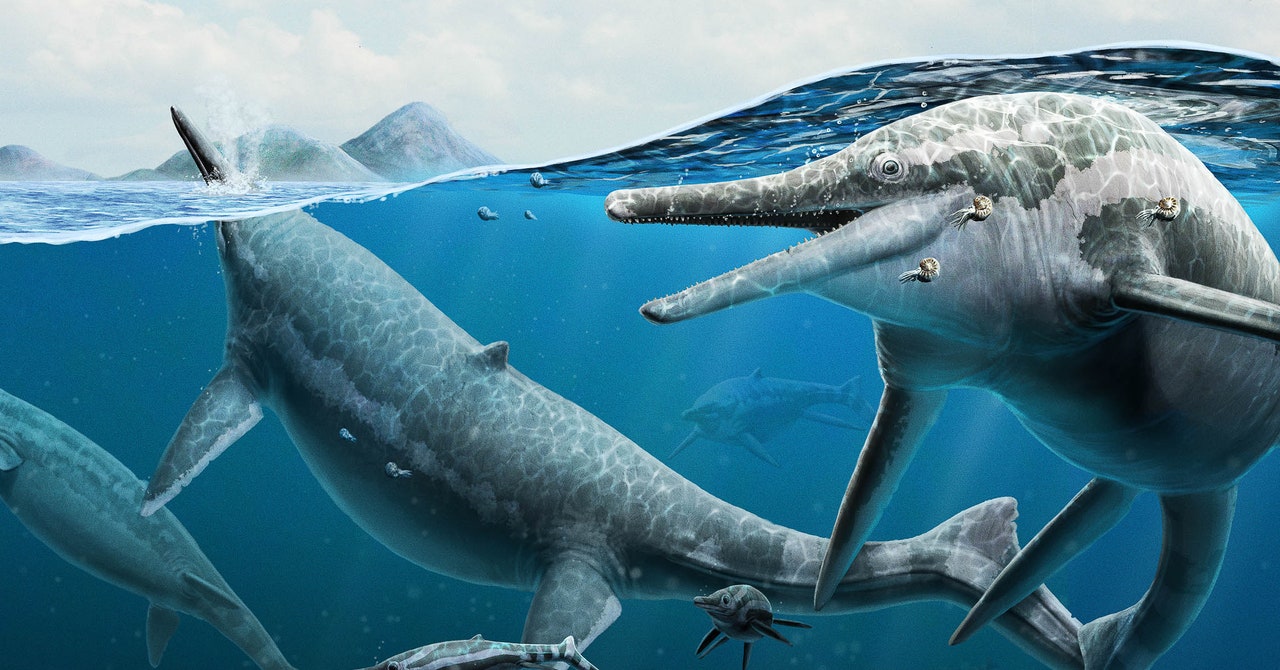
Berlin, Nevada, is a treasure chest for paleontologists. Just down the road from now-abandoned gold and silver mines, a rockbound collection of bones hints at an even richer past. The Berlin-Ichthyosaur State Park is teeming with dozens of fossils of ancient marine reptiles. That bone bed is so abundant and weird that researchers have been scratching their heads over it for decades.
“There are sites with way more dense occurrences of ichthyosaur skeletons, including places in Chile and Germany,” says Nick Pyenson, curator of fossil marine mammals at the Smithsonian National Museum of Natural History. “But this place, Berlin-Ichthyosaur in eastern Nevada, has really escaped explanation for a long time.” In one particular quarry, at least seven individuals from the genus Shonisaurus—a bloated, bus-sized dolphin with four limb-like flippers—lay essentially stacked atop one another.
Previous hypotheses largely focused on physical or environmental reasons for the cluster of fossils. One suggested that the animals had gotten stranded in shallow water and died as a group some 230 million years ago. Or maybe a volcanic eruption did them in. Pyenson had another hunch, one that his team tested using 3D visualizations of the site, as well as fossils and other clues in the geological record.
Writing in the journal Current Biology, today Pyenson’s team presents evidence that the shonisaurs came there to reproduce. The team concludes that the animals migrated long distances to give birth, like some whales do today. The discovery not only represents an example of “convergent evolution,” in which the same traits independently evolve in different species, but also the oldest example of migration in groups to a designated calving ground.
“They’re making quite a convincing case,” says Lene Liebe Delsett, a vertebrate paleontologist at the University of Oslo, Norway, who was not involved in the study. “Ichthyosaurs were the first large marine tetrapods. And throughout the Triassic, they varied quite a lot, so there was a large diversity. It’s just a very interesting period of time to know more about.”
The origin story of the shonisaurs begins with death—a lot of it.
Some 251 million years ago, between the Permian and Triassic periods, Earth’s biggest extinction event annihilated about 95 percent of all marine species. This so-called “Great Dying” mowed down the diverse landscape of creatures in the ocean.Some of the animals that grew back in their place turned out to be weirder and larger than ever before.
The ensuing Triassic started an evolutionary arms race. Prey evolved harder shells and better mobility, predators crunched through ammonite shells and hunted fish better than ever, and so on. Ichthyosaurs, which evolved from terrestrial reptiles into new species of various sizes, partly drove this pressure and quickly dominated the ocean. The Shonisaurus genus, in particular, grew to be some of the largest marine predators around. “They achieved whale sizes before anything else,” says Pyenson.
Pyenson is normally more of a whale guy; he specializes in mammals, which split from reptiles about 325 million years ago. But ancient marine reptiles like those under the order Ichthyosaur bear many similarities to existing marine mammals. Their ancestors came from land, they birthed live young, they had similar flippers, and they are tetrapods, meaning four-limbed. And Pyenson is well versed in this type of mystery. About a decade ago in Atacama, Chile, he and his South American collaborators used 3D mapping and chemical analyses to show that a tight cluster of at least 40 fossilized whales must have died from a toxic algal bloom 7 to 9 million years ago.


